7 Spirit Airlines flights in 5 days: The good, the (not too) bad and the annoying
Tell someone you’re flying Spirit Airlines and you’ll likely be greeted with sympathy or disdain.
The budget airline with the distinct yellow planes, cheap fares, flurry of fees and historically spotty service has long been seen as something to endure or avoid.
Spirit draws daily hate on social media, five years after it famously launched a “Hug the Haters’’ campaign to address its then “different approach’’ to air travel.
"Spirit Airlines I gave you a chance. You are dead to me,'' passenger Jerome Bartlett said on Twitter last week after his red-eye flight from Las Vegas to Houston was delayed more than 12 hours. "I'd rather go through a root canal than endure what I went through here tonight again.''
So imagine the comments when I told friends I was taking seven Spirit flights in five days. One called it a “torture tour.” Another called it “enough Spirit flights for a lifetime.’’
I called it a test of Spirit’s nascent turnaround and, spoiler alert, the airline passed, with surprisingly good grades. The flights were on time, the much-maligned seats perfectly fine, flight attendants friendly, and I only spent $3 on board, for a Diet Coke on one flight.
13 do's and don'ts on Spirit: Don't freak out about the seats, do sign up for deals
Spirit has dramatically improved its operations and customer service in the past few years under new management, with employee training, schedule fixes, a focus on metrics and more. All in a bid to improve its image and spur repeat business. Its new mantra: "The best value in the sky.''
The early results are encouraging:
Spirit has the third-best on-time performance (80.7%) in the industry year to date through May, behind only Hawaiian and Delta, according to figures from the federal Bureau of Transportation Statistics. That’s on top of a fourth-place finish for all of 2018, including a No. 1 ranking in October 2018 that turned heads and prompted Spirit to trumpet the ranking. In 2015 and 2016, Spirit had the worst on-time performance in the industry, and in 2017 it was near the bottom.
Spirit’s cancellation rate is 1.5% year to date, up slightly from a year ago (the airline stretched the operation too thin after a banner 2018 and expects lingering effects throughout the rest of the year), but down significantly from the same period in 2017 when it was 3.2%.
Spirit had the fewest mishandled bags in the industry last year through November, according to the Air Travel Consumer Report.
Complaint levels are still among the highest in the industry but are a fraction of previous levels.
“The company made a decision to focus more on the operation and the guest,’’ said Greg Christopher, who left Southwest Airlines in early 2016 to join Spirit as vice president of its operations control center. “Up until that point we had been focusing on growing, and we did a lot to kind of revolutionize the industry, but we hadn’t invested a lot in the operation or the guest experience."
Spirit has a new clock at the airline's operations control center with the number of days, hours, minutes and seconds since the last flight cancellation within the airline's control. When it's reset, the department that was to blame has to push the remote, Christopher said.
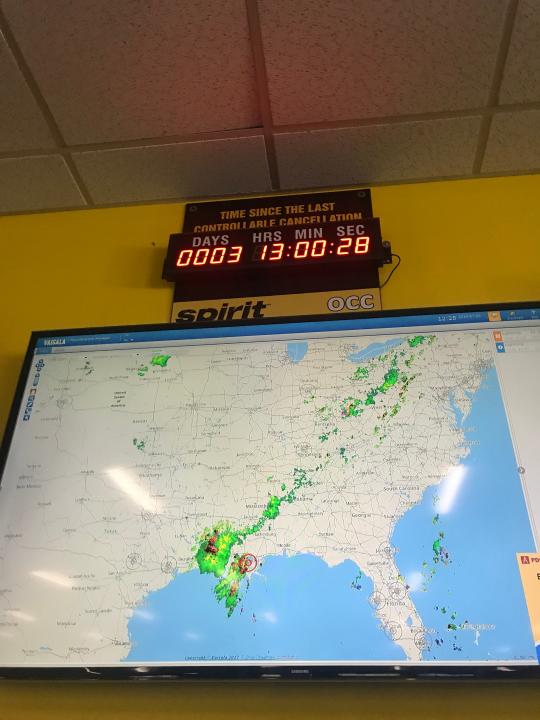
Flying Spirit around the country
To test fly Spirit, I picked seven flights across the country over five days in late July, departing on a Friday afternoon and returning late Tuesday. The itinerary: Chicago-Las Vegas-Los Angeles-Dallas-New York-Fort Lauderdale-Raleigh-Chicago.
There was a mix of short and long flights, including two of the airline’s busiest routes, Chicago-Las Vegas and New York-Fort Lauderdale, during peak and nonpeak times (1:30 a.m. arrival into Dallas, or 6:30 a.m. flight from New York's LaGuardia Airport, anyone?).
Until then, I had taken only one Spirit flight: an uncomfortable 30-minute hop between Florida and the Bahamas in 2011. My knees were jammed into the seat in front of me. (The airline has since gotten new seats, going from a flat back to a curved back to offer more legroom, and even better seats are on the way, Christopher said).
But I knew what I was getting into. Spirit pioneered the a-la-carte model – it now calls it "a la smarte" – that has been gradually copied by major airline competitors in the past decade. The only major things Spirit charges for that American, Delta and United still offer for free: carry-on bags and in-flight snacks and soda, juice and water. (United doesn’t allow a free carry-on with its basic economy fares.)
It also crams more seats onto its planes than other airlines and has zero in-flight entertainment, no Wi-Fi, movies or even an airline magazine.
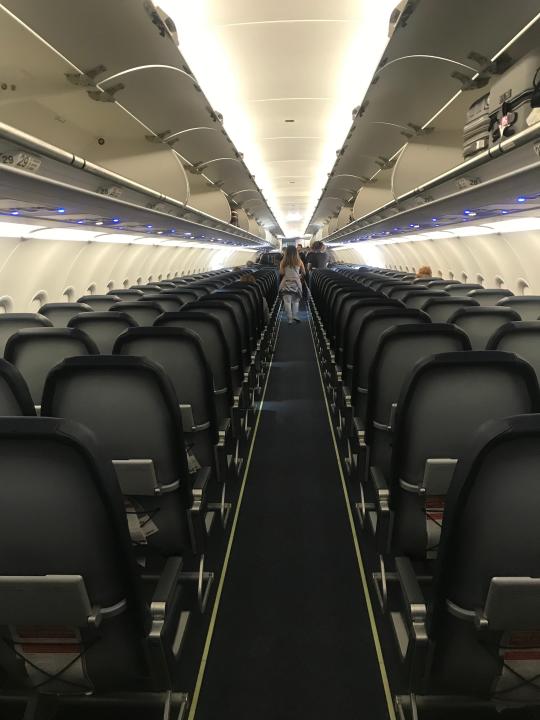
It’s worth noting that I booked the flights last minute, all but a couple less than a week out, so in most cases didn’t nab any of those eye-popping fares Spirit advertises. Translation: I didn’t go into the trip with an “I can tolerate anything because I paid virtually nothing’’ mentality.
The priciest trip, from Dallas Fort Worth International Airport to New York LaGuardia and, a day later, New York to Fort Lauderdale, Florida, was $400, or $562 including a bag and Spirit’s comfy, first-class-like Big Front Seats on each leg. The base fare was about $100 cheaper than competitors were offering at the time.
Booking Spirit flights: an exercise in patience and upselling
The most stressful part of flying Spirit, in my experience at least, was buying tickets on the airline’s website.
It’s not as simple as picking your flights and pulling out your credit card. There are so many decisions to make.
Join the $9 fare club, which offers discounts on airfare and bags, or not? I did because I was booking multiple flights and recovered the $60 one-year club fee in fare and baggage-fee savings on the first flight.
There’s math: buy a bundle of perks called the Thrills Combo or pay for things like bags and seats separately? I only purchased it for one flight, from Los Angeles to Dallas, for $54 and that covered a carry-on bag, a checked bag, an exit-row seat, priority boarding, double frequent-flyer miles and a one-time waiver of Spirit’s $90 change fee. I didn’t need most of those perks so probably overspent.
Another decision: pay for a seat or chance it? If you don’t pay for a seat, Spirit assigns one for free during online check-in or at the airport, as its competitors do with their basic economy fares.
Spirit passengers can reserve, in order of price, a regular seat, exit-row seat or one of the Big Front Seats, if available. The fees vary by flight and are dynamic, so you’ll pay more as the flight approaches if it’s full. My seat fees for seven flights totaled $147, the bulk of it to reserve the Big Front Seats on two flights.
Yet another decision: pay for bags now or at the airport? I paid in advance for a carry-on bag for every flight because a) I couldn’t cram my clothes, toiletries and laptop into the “personal item’’ Spirit allows for free, b) didn’t want to check a bag, even though it was cheaper and c) Spirit charges more for bags at the airport.
Before you pay for the flight, Spirit also peddles hotels and rental cars and flight “check-in options.’’ One of them: prepay $10 per person each way if you need an airport agent to print your boarding pass.
I declined, using mobile boarding passes from Spirit’s app or printing them at airport kiosks for free.
The Spirit sales spiel isn’t done after you click purchase: I was pitched offers for Hello Fresh, Hulu, Blue Apron, StubHub, teeth whitening and even AARP.
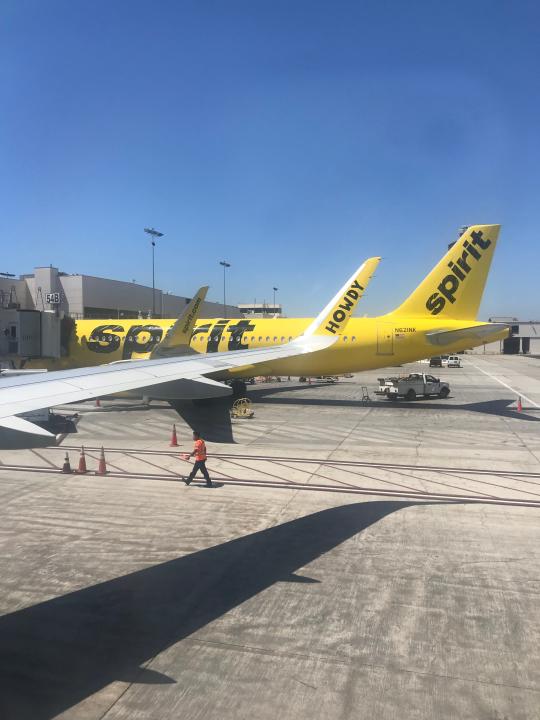
Spirit at the airport: Repacking stations for bags over the 40-pound weight limit
I never had to wait in a check-in line since I was traveling with a carry-on bag but did notice this before almost every flight: travelers yanking stuff from their suitcases in the airport lobby because their bag was overweight. Spirit’s weight allowance for checked bags is 40 pounds, versus 50 at most carriers. (Travelers who buy one of Spirit’s combo packages get a 50-pound allowance.)
The airline has set up repacking stations, complete with signage, to try to keep things orderly.
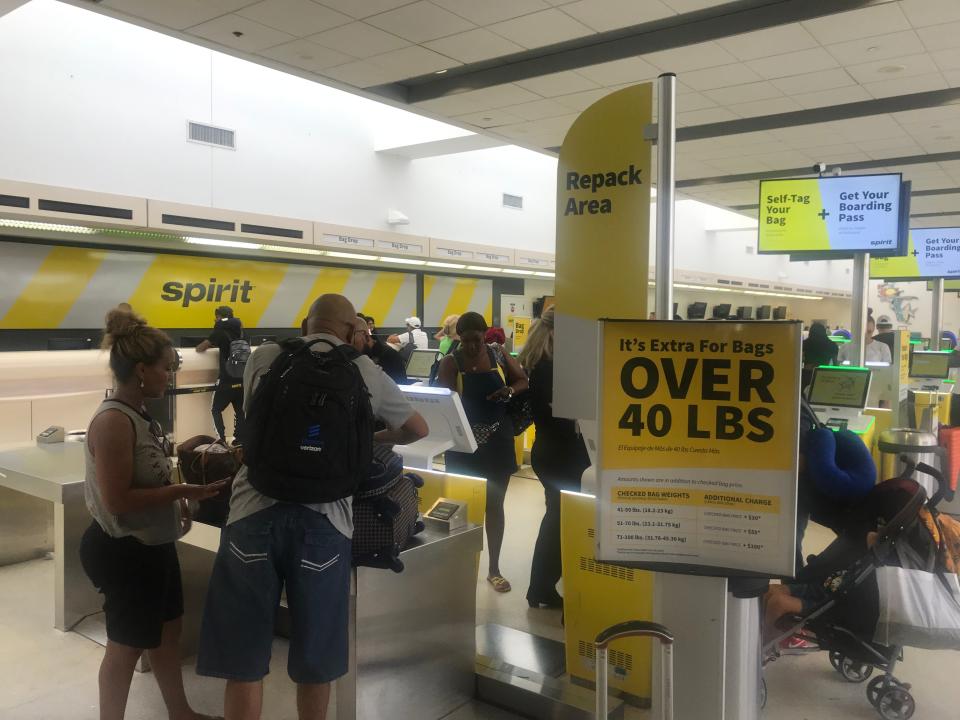
One of the few wrinkles in my trip happened ahead of the first flight, from Chicago to Las Vegas. I had problems checking in on Spirit’s mobile app (a problem that would resurface) so switched to my laptop and checked in without a problem.
I didn’t notice that my boarding pass didn’t have TSA PreCheck on it until I arrived at Chicago O’Hare International Airport. And by then it was too late, at least according to the not-very-sympathetic agent at the Spirit ticket counter. She could see the known traveler number (KTN) in my reservation but said there was nothing she could do.
“I’m sorry, ma’am, it’s a systems issue,’’ she said.
I asked her if she could waive the $7 fee for shortcut security (an option Spirit sells during booking), and she said no.
Thankfully, the regular security line wasn’t too long.
I had PreCheck on my next flight. But it wasn’t on the boarding pass for my third flight, an early morning flight from Dallas to New York LaGuardia.
A helpful Spirit agent named Paris figured out the problem: some of the reservations had a couple of extra numbers in the KTN. I don’t know how that happened or who was to blame, but unlike other airlines, Spirit asked me to manually enter my KTN every booking even though it was in my profile.
Spirit Airlines now boarding Zone 1
A big plus of paying for the carry-on bag fee: you get to board first, in Zone 1, regardless of where you’re sitting on the plane or whether you paid for your seat assignment.
The Zone 1 line was the shortest boarding line on each of my flights, and if you somehow missed the call to board, you still got to jump the line after regular boarding started. Not paying for a carry-on? You can pay a "shortcut boarding fee'' to get in Zone 1.
Even though the gate areas were packed with passengers, the overall boarding process was orderly, better than I’ve seen on some Southwest Airlines flights. (Southwest famously doesn’t assign seats, instead, assigning boarding positions, and passengers then are free to pick any open seat.)
I was only asked once to change seats so a family could sit together. I traded for another aisle seat, as I had paid for one.
One thing I didn’t notice on any of my Spirit flights, which surprised me: enforcement of the airline’s carry-on bag policy. I sat next to several passengers with carry-ons that were bigger than the allowed personal item, and/or they had that and another personal item, and none had paid a fee to bring it on.

It’s probably not worth chancing: Spirit charges a hefty $65 one way for a carry-on or checked bag at the gate.
Flying Spirit: Tiny tray tables, $3 Cokes and credit card pitches
I got lucky, and Spirit assigned me aisle seats on the first two flights after I declined to pay to reserve a seat, despite several nudges that it was an option. Both were in the back of the plane, which didn't bother me because that was closer to the bathroom.
The first thing I noticed when I plunked down in seat 29D on the Airbus A320 from Chicago to Las Vegas, my first flight, had nothing to do with legroom or seat comfort or the lack of a traditional seatback pocket. (Let's call it a seatback net, which holds nothing more than the safety information card and the drink and food menu.)

It was the tiny tray table, about the size of a business envelope or small clutch. It's sturdy, but a laptop swallows it. It fits a drink, a phone and a snack. In seven flights, I don't recall seeing any passengers using laptops on the tray table. One passenger in front of me awkwardly opened his laptop on the empty seat next to him.
The flight attendants joked about the size of the table on my flight to Las Vegas during the pre-takeoff briefing: "We know those tray tables are pretty tiny, but they still need to be stowed.''
About those much-maligned Spirit seats: Unless you're used to flying first class or paying up for cushier seats on other airlines, they are perfectly fine. I was in an ordinary seat for four of the seven flights (three aisle seats and a window). Yes, they are thin and they don't recline. But I found the legroom to be adequate (I'm 5' 6'', average build) and never felt uncomfortable, even on the longer flights. In seven flights, I saw only a few passengers near me whose knees were jammed up against the seatback, one because she was tall and had an overstuffed backpack underneath the seat and had to put her feet on top of it. I've had more uncomfortable seats in the exit row on an American Airlines flight.

About those much-praised Big Front Seats: Splurge if you can afford it, especially if you nabbed a cheap fare. I paid $60 for one of the seats from Dallas to New York and $41 from New York to Fort Lauderdale. The large, comfy seats are in the first couple rows of the plane with no middle seat. Legroom and elbow room are plentiful, and there's a headrest and traditional seatback pocket. Note that these seats don't recline, either. Think of it as a first-class upgrade minus the free drinks and food and the traditional curtain, at a fraction of the price. More than one passenger walking by during boarding called it first class.

A happy medium: an exit row seat. An exit row seat came with the Thrills Combo I purchased on one of the flights. The asking price for an exit-row seat on my flights was $14 for a short flight (Las Vegas-Los Angeles) and $32 for a long flight (Chicago-Las Vegas.) Prices vary by flight and other factors.
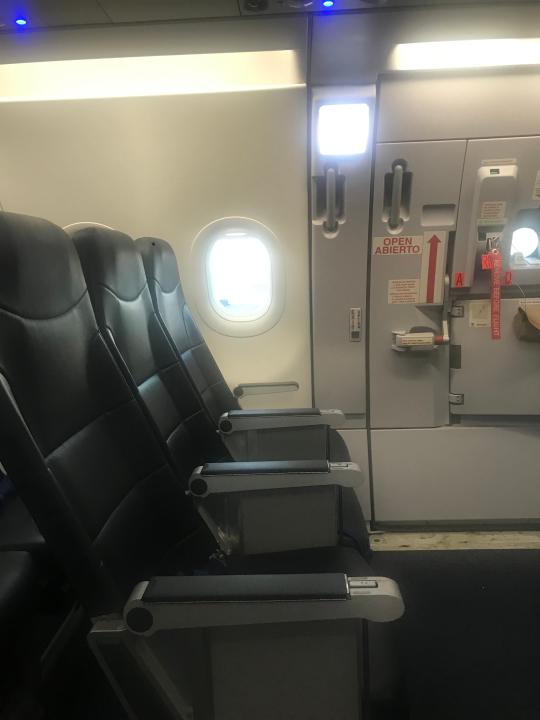
Hungry or thirsty? Bring your own (except alcohol) or pull out your credit card. Friendly Spirit flight attendants wheel the food and drink cart down the aisle like flight attendants on other airlines, but their trips are quicker because, at least on my flights, sales of $3 cokes, $4 peanut M&Ms and $9 BuzzBallz premade cocktails weren't brisk. One passenger ordered a Sprite and then declined when he was told it was $3. Another passenger asked if anything, including water, was free? "No,'' the flight attendant replied. One surprisingly popular item: the daily special of a coffee and muffin for $4, a $1 savings. The flight attendant on one of the flights pitched them as freshly made, but they were packaged Otis Spunkmeyer muffins. Flight attendants also warn passengers that they are not allowed to drink their own alcohol on the flights.
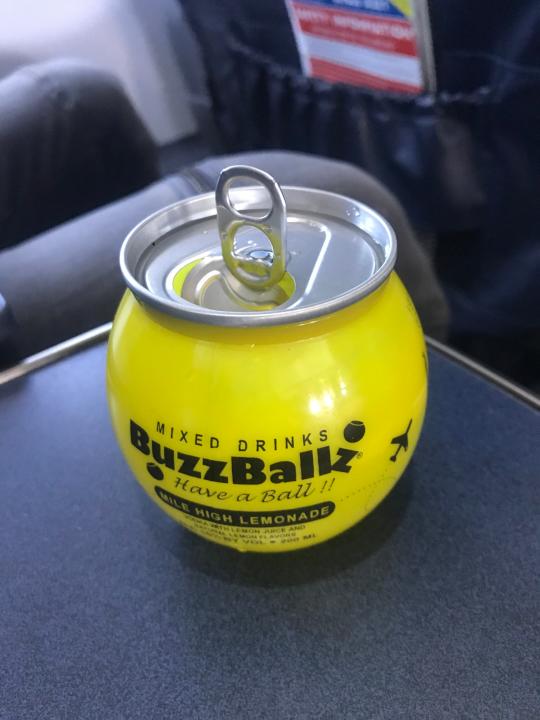
BYOE: Bring your own entertainment. With most major airlines offering Wi-Fi (usually for a fee) and many, including Southwest, offering free messaging, it was hard to be disconnected on Spirit flights. (The airline says Wi-Fi is coming, but it's taking longer than expected.) I had music and audiobooks for my Spirit flights but ended up buying a paperback at the airport to pass the time. Note that Spirit has no power outlets or USB ports to charge your devices.
Be prepared for the corny credit card pitch: In-flight credit card pitches aren't unique to Spirit, of course, but the airline tries to grab passengers' attention with a contest on some flights. In the final hour of the Chicago-to-Las Vegas flight, the flight attendant told passengers to look on their tray table for a yellow sticker. It was good for 5,000 Spirit miles. The lucky winner was in seat 18E, a middle seat. On the flight from Dallas to New York, the winner was in 33E. The winner is always in the middle seat it turns out.
"The next time you're sitting in a middle seat thinking about how uncomfortable you are, you might be the lucky seat,'' a flight attendant said.
The sales pitch, which didn't occur on every flight, comes after the contest: fill out a credit card application and receive 30,000 bonus miles, with an extra 1,000 if you turn in the application that day. I passed.
My flights were all on time: Chalk it up to a combination of good weather across the country, good luck and Spirit's focus on its operation, but my seven Spirit flights went off without a hitch. And, aside from a lengthy delay on a flight from Los Angeles to Chicago at a neighboring gate, I didn't see a spate of Spirit flight troubles in my travels through seven airports. I'd fly the airline again even if my employer wasn't paying, especially if Spirit's fares were cheaper and it wasn't a red-eye.
Christopher said Spirit continues to work on its operation and customer service so passengers take flight troubles in stride, as they often do on bigger airlines like Southwest and other carriers where he has worked.
"They have problems, too, and they don't always do the best they could have, but they tend to get a pass sometimes because of their previous reputations, whereas, we'll be called out right away for the same exact situation,'' he said. "But that also brings us to a higher standard.''
The airline is also going beyond the norm to re-accommodate travelers, he said, including busing a group of passengers from Austin, Texas, to Dallas after they were diverted.
Garmens Raymond, 25, flies Spirit about six times a year, most recently visiting family in Haiti and Costa Rica. He picks Spirit for the cheap fares, never paying for a bag or a seat, but said he's noticed an uptick in service and cleaner, more comfortable planes.
"In the past, I would say they were terrible,'' he said. "Now I've seen a good improvement.''
This article originally appeared on USA TODAY: Spirit Airlines: 7 flights, 5 days, 1 carry-on, 0 delays or big issues

